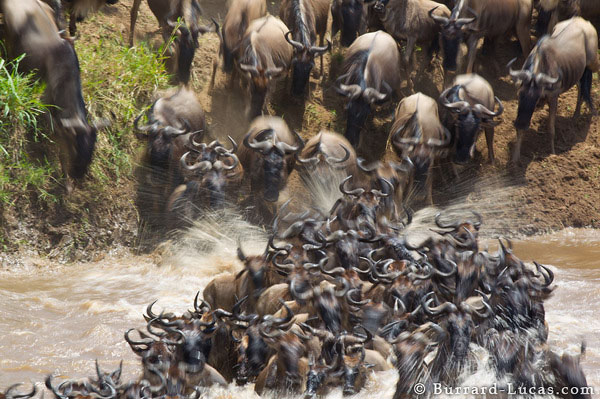The sheer scale and geographical spread of major migrations makes photographing such events a huge challenge. It is simply impossible to show the scale of the whole event and single still images, however skilfully created, cannot convey the drama involved. The most widely photographed mass migration is that of the wildebeest in the Serengeti.
Long sinuous lines of wildebeest can be seen extending from horizon to horizon across the vast grasslands of Tanzania. Individual lines merge and divide, some following routes a few miles from others. However, in a few locations, the animals converge on specific points. The best known of these are the crossing points on the Mara River. Tens of thousands of animals congregate at the most convenient points to cross the river at any one time. Here, they animals may pause on the river banks for hours before the braver individuals pluck up the courage to face the water and the waiting crocodiles. One a few animals begin to cross, thousands of others follow. Once the flow is underway, five or ten thousand animals may cross in a relatively short period. Some wildebeest do not make it alive. The crocodiles kill hundreds as they struggle in the fast-flowing water.
 |
| Wildebeest migration, Serengeti - Image by kind permission of Burrard-Lucas.com |
Several approaches are possible but all involve considerable investments of time, money, effort and imagination. Photographs taken from vehicles, even when positioned within the lines of charging animals, struggle to convey the noise, smell and scale of the events.Billions of flies move with the migrating animals but details such as this are largely lost in images. Some photographers have used remotely controlled cameras disguised as rocks or clumps of grass to obtain close-up images from ground level, and others have used aerial photography to look down on the meandering lines of the migration. On the banks of the Mara River a photographer has the advantage of a slightly raised viewpoint in addition to the accumulation of animals and the spectacular challenges they face, so this is a much-used location.
Bird migrations are perhaps the most difficult of all to photograph. Images taken from the ground are restricted to showing beautiful formations of birds heading in a particular direction, but aerial work arguably reveals the most interesting results. Migrating formations are captured against a backdrop of the landscape and, with appropriate equipment and expertise, can be approached fairly closely.






